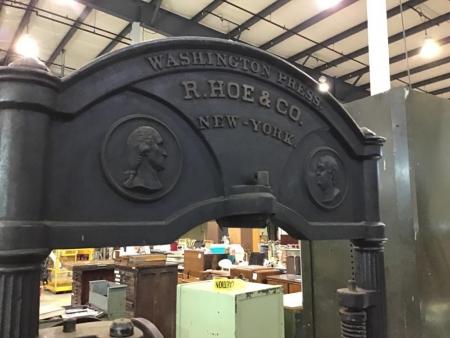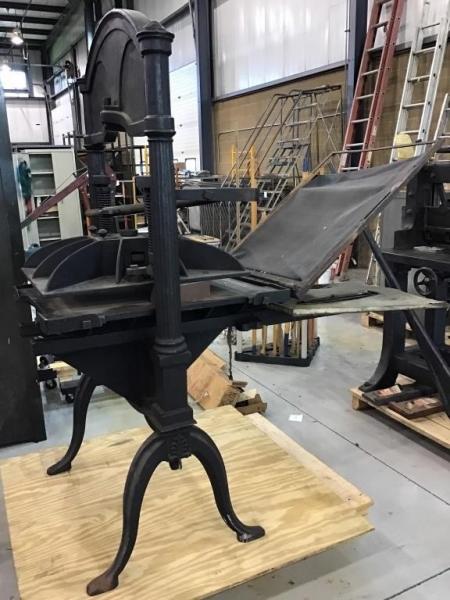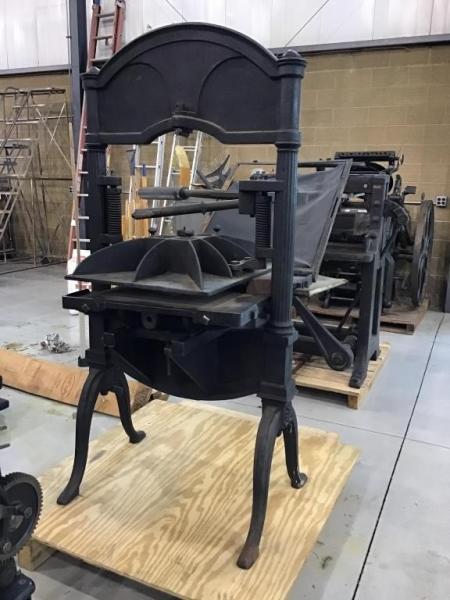Help with R. Hoe Washington Press
Hello Forum.
I’ve salvaged an incomplete R. Hoe Washington press.
I can’t seem to find a serial number. It’s not prominate on the frame placard.
Can someone please point me in a direction to get history on this press and how I can figure out what parts are missing?
Thanks

94CF1459-7C14-43BD-85C0-8B706AA02967.jpeg

8D797540-AD9B-4EA8-91E1-6C2C5666249B.jpeg

A16ACDE5-2AF9-4364-B6E7-C23446D2B256.jpeg
Even with a serial number, the pre-1850 history of any R Hoe Washington press is seldom traceable.
*This press has the elements of being made pre 1860.
*The shape of the flutes on the columns and the base are all from the era when iron hand presses were used for printing newspapers and not primarily proofing.
*The platen is attached with double bolts on each side vs single bolts of later presses. Also the number of ribs on the platen is less than those made in the later years of Hoe manufacture.
*The pole (forestay) holding up the rear of the rail assembly is easily replaced with either a wood frame, a single metal rod or even an antique soda fountain stool base. All would look age appropriate and be low cost.
*Replacing the 3-piece “A” shaped toggle is your big concern and is complicated to reproduce for even a journeyman machinist, although with 3-D scanners you might be able to replicate working plans from a similar era press. Unsure of anyone who has done so yet.
*The rounce (round barrel-like dowel) along with the handle which, together with leather straps, winds the bed in-out from under the platen is missing in photos. All complicated to manufacture unless you can copy from a complete press.
*Early Hoe press sizes are slightly different in the earliest of Hoe catalogs than those or same size in the later ones, which may or may not make buying a donor press chancy without the knowledge of someone uniquely familiar with the subtleties.
*Further examination and identification is made difficult with existing photos and lack of platen and bed sizes.
*If you are from the Detroit area (only guessing), go to the Henry Ford Museum and compare. Pretty sure there is one similar Hoe in the museum, and two at the print shop in Greenfield Village. You might arrange for private access if the Covid problem has them closed. Other wise contact Bob Oldham (on this site) and perhaps he can provide you with another age-appropriate duplicate, owner or possible donor press.
1840 to 1850 range. we have similar in our museum. Photos on our web site. howardironworks.org
Thanks Butch.
Very insightful.
I figured the restoration for this is way out of my means.
But I couldn’t let something with so much history go to scrap. (Regardless of the shape it’s in.)
This may never function again. But it’s beautiful and a heck of a conversation piece for the garage right now.
I would at least talk to Howard Iron Works to see if they take on outside work or can offer advise. Their skills and knowledge are trustworthy. Talented restorers who understand old iron & steel are far rarer than old presses. Here, west of the Mississippi, we lost just such a person 12yrs ago and to my knowledge, that void has never been filled.
To a novice it may seem like all these old iron hand presses can be easily re-worked with replacement or found parts. Seldom recognized or addressed on this site are such things as: Has the bed and, perhaps not quite as important, the platen been “re-ground” to be flat? It can be difficult to find shops with large grinding stones and appropriate machinery to accomplish such a task. Is the adjusting wedge located in the head the platen worn to the point of making the platen fall unevenly? Is the rail track worn evenly enough to afford allowing the bed to move in-out as intended? A replaced bed will seldom match the wear pattern of the rails, and visa versa. Certainly many other concerns as well.
There may always be a machinists who can re-create missing parts. Few are left who understand how to restore these simple presses to function as intended.
I think probably closer to 1850. But there was quite a variability of Hoe presses in that period. If you have the press, what is the condition of the rails the bed moves on? They do not look in the one photo that shows any of them, to be as long as they must be to fully support the bed. What was under the frisket or whatever that was lying on the rails below the open tympan.
I do have quite a large number of Hoe Washingtons from that period recorded among the roughly 180 Hoe hand presses in the database. One of the characteristics of the making of them was that details and decorations on the head were added in the mold sand with individual stamps and sometimes got out of place or left out entirely. The serial number seems to have been forgotten, though other presses from that period have them.
I am happy to help in locating examples from which the missing parts could be copied. I assume the other person who posted about this press last week failed to get it. The problems of restoring it are large. Nick can probably do it, but not inexpensively.
Bob
Check the front side of the winter for a number - a very few Hoe Washingtons have their number in that location.
Bob